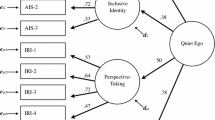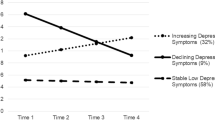Abstract
An underexamined component of Erik Erikson's psychosocial theory is the concept of ego strengths. The eight ego strengths are present throughout the life span, but each have their ascendance in conjunction with successful psychosocial stage resolutions. Upon careful analysis of Erikson's writings, the Psychosocial Inventory of Ego Strengths (PIES) was developed to assess this component of psychosocial theory. The measure was scrutinized by several Eriksonian scholars for its face and content validity. Then, two studies were conducted among college samples in the United States and Canada. Evidence for internal consistency was shown for the eight ego strengths, as well as on overall score. Convergent validity was shown between the PIES and assessments of identity achievement, self-esteem, purpose in life, internal locus of control, and sex roles. Discriminant validity was observed in negative correlations between the ego strengths and hopelessness, identity diffusion, identity moratorium, and personal distress. Suggestions for future research utilizing this measure are given.
Similar content being viewed by others
REFERENCES
Adams, G. R., Bennion, L., and Huh, K. (1989). Objective measure of ego identity status: A reference manual. Available from Gerald Adams, Department of Family Studies, University of Guelph, Guelph, Ontario.
Adams, G. R., Shea, J., and Fitch, S. A. (1979). Toward the development of an objective assessment of ego-identity status. J. Youth Adolesc. 8: 223–237.
Beck, A. T., Steer, R. A., Kovacs, M., and Garrison, B. (1985). Hopelessness and eventual suicide: A 10-year prospective study of patients hospitalized with suicide ideation. Am. J. Psychiat. 142: 559–563.
Beck, A. T., Weissman, A., Lester, D., and Trexler, L. (1974). The measurement of pessimism: The hopelessness scale. J. Consult. Clin. Psychol. 47: 861–865.
Bem, S. L. (1974). The measurement of psychological androgyny. J. Consult. Clin. Psychol. 42: 155–162.
Bem, S. L. (1977). On the utility of alternative procedures for assessing psychological androgyny. J. Consult. Clin. Psychol. 45: 196–205.
Blascovich, J., and Tomaka, J. (1991). Measures of self-esteem. In Robinson, J. P., Shaver, P. R., and Wrightsman, L. S. (eds.), Measures of Personality and Social Psychological Attitudes. Academic Press, San Diego, CA.
Crumbaugh, J. (1968). Cross-validation of a purpose-in-life test based on Frankl's concepts. J. Indivi. Psychol. 24: 74–81.
Davis, M. H. (1980). A multidimensional approach to individual differences in empathy. Cat. Select. Doc. Psychol. 10: 85.
Erikson, E. H. (1964a). Insight and Responsibility. W. W. Norton, New York.
Erikson, E. H. (1964b). A memorandum on identity and Negro Youth. J. Social Issues 20, 429–442.
Erikson, E. H. (1965). Youth: Fidelity and diversity. In Erikson, E. H. (ed.), The Challenge of Youth. W. W. Norton, New York.
Erikson, E. H. (1968a). The human life cycle. In International Encyclopedia of the Social Sciences. Crowell-Collier, New York.
Erikson, E. H. (1968b). Identity: Youth and Crisis. W. W. Norton, New York.
Erikson, E. H. (1968c). Psychosocial identity. In International Encyclopedia of the Social Sciences. Crowell-Collier, New York.
Erikson, E. H. (1985). The Life Cycle Completed. W. W. Norton, New York.
Gilligan, C. (1982). In a Different Voice: Psychological Theory and Women's Development. Harvard University Press, Cambridge, MA.
Lenney, E. (1991). Sex roles: The measurement of masculinity, femininity, and androgyny. In Robinson, J. P., Shaver, P. R., and Wrightsman, L. S. (eds.), Measures of Personality and Social Psychological Attitudes. Academic Press, San Diego, CA.
Marcia, J. E. (1966). Development and validation of ego identity status. J. Personal. Social Psychol. 3: 551–558.
Markstrom-Adams, C. (1989). Androgyny and its relation to adolescent psychosocial well-being: A review of the literature. Sex Roles 21: 325–340.
Markstrom-Adams, C., Hofstra, G., and Dougher, K. (1994). The ego-virtue of fidelity: A case for the study of religion and identity formation in adolescence. J. Youth Adolesc. 10: 453–469.
Nowicki, S., and Strickland, B. R. (1973). A locus of control scale for children. J. Consult. Clin. Psychol. 40: 148–154.
Rosenberg, M. (1965). Society and Adolescent Self-Image. Princeton University Press, Princeton, NJ.
Rosenthal, D.A., Gurney, R.M., and Moore, S.M. (1981). From trust to intimacy: A new inventory for measuring Erikson's stages of psychosocial development. J. Youth Adolesc. 10: 525–537.
Seeman, M. (1991). Alienation and other constructs. In Robinson, J. P., Shaver, P. R., and Wrightsman, L. S. (eds.), Measures of Personality and Social Psychological Attitudes. Academic Press, San Diego, CA.
Author information
Authors and Affiliations
Rights and permissions
About this article
Cite this article
Markstrom, C.A., Sabino, V.M., Turner, B.J. et al. The Psychosocial Inventory of Ego Strengths: Development and Validation of a New Eriksonian Measure. Journal of Youth and Adolescence 26, 705–732 (1997). https://doi.org/10.1023/A:1022348709532
Issue Date:
DOI: https://doi.org/10.1023/A:1022348709532




